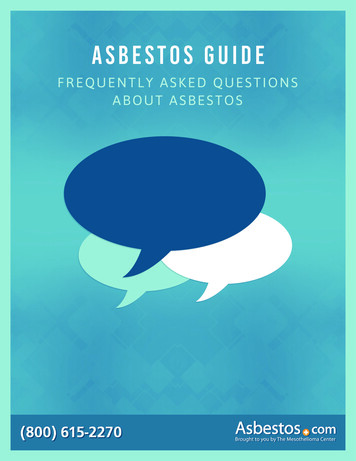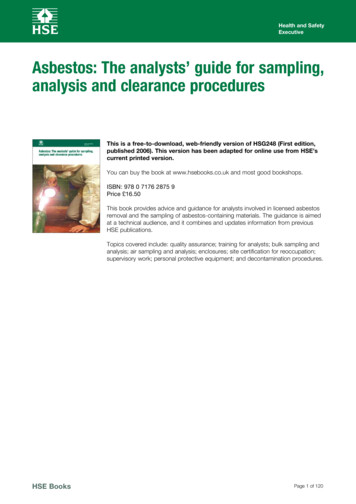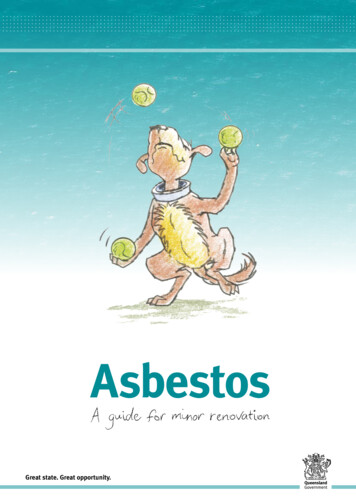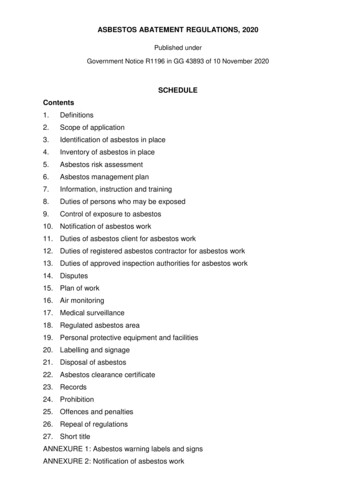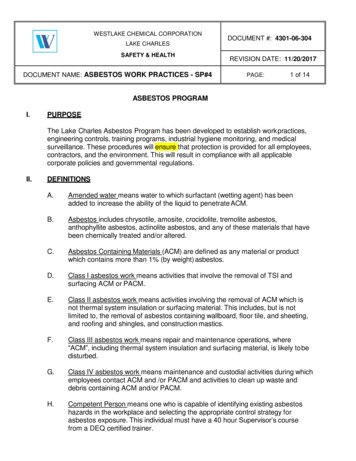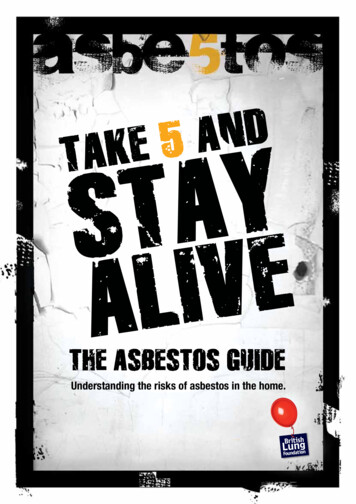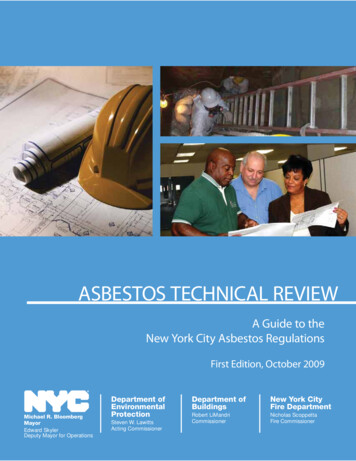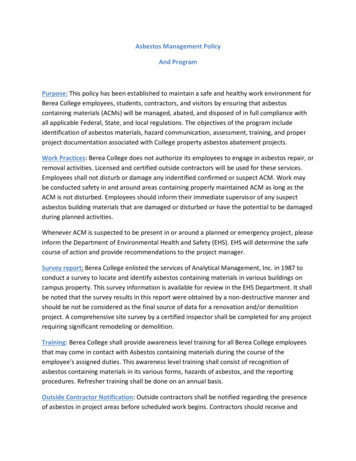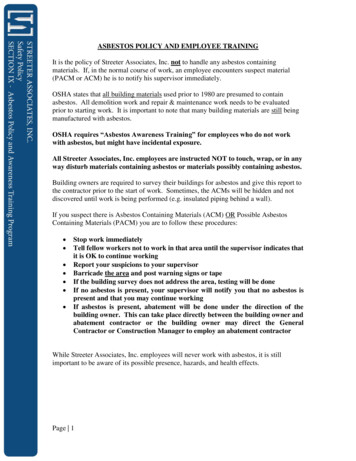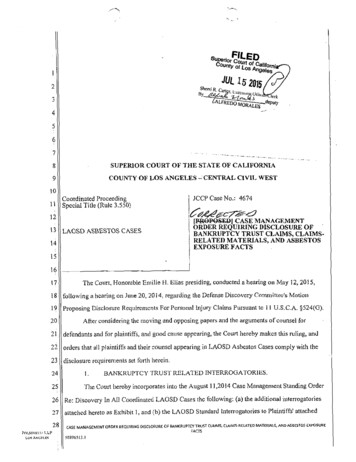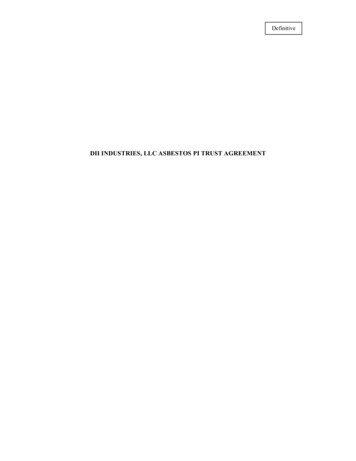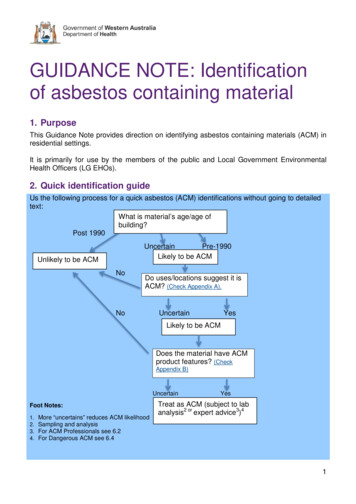
Transcription
GUIDANCE NOTE: Identificationof asbestos containing material1. PurposeThis Guidance Note provides direction on identifying asbestos containing materials (ACM) inresidential settings.It is primarily for use by the members of the public and Local Government EnvironmentalHealth Officers (LG EHOs).2. Quick identification guideUs the following process for a quick asbestos (ACM) identifications without going to detailedtext:What is material’s age/age ofbuilding?Post 1990UncertainPre-1990Likely to be ACMUnlikely to be ACMNoDo uses/locations suggest it isACM? (Check Appendix A).NoUncertainYesLikely to be ACMDoes the material have ACMproduct features? (CheckAppendix B)UncertainFoot Notes:1.2.3.4.More “uncertains” reduces ACM likelihoodSampling and analysisFor ACM Professionals see 6.2For Dangerous ACM see 6.4YesTreat as ACM (subject to labanalysis2 or expert advice3)41
In Western Australia many older residential and commercial buildings built pre-1990 (possiblyup to 75 per cent), may contain asbestos, mainly as cement sheeting in walls, ceilings,eaves, fences and roofs. Occasionally it may occur in other forms in limited amounts such asthe backing for sheet linoleum, within vinyl floor tiles, some fibre boards and as non-bonded(friable) material for insulation purposes.3. ACM general principles If suspect material satisfies age, use and appearance criteria for ACM, it is best toassume it is ACM until professionally assessed, or subject to laboratory analysis.Non-friable ACM (i.e. not loose) is unlikely to pose a risk if in a good condition and notphysically disturbed.Even if in sound condition, early proper removal of ACM (which is still aging) should beconsidered especially in conjunction with any other property renovations ordevelopment.Any ACM disturbance should, and in some cases must, be undertaken by ACMprofessionals.4. BackgroundACM was extensively used in Australianproducts from the 1940s until about 1987when its use ceased in the buildingindustry. Use of ACM was totally bannedin 2003.As a result of its extensive use, Australiahas some of the highest asbestos-relateddisease (mesothelioma) rates in the world.The cause of most of these diseases wasdue to high levels of ACM exposure in theasbestos mining, milling and installationindustries. However, in more recent timesasbestos-related diseases are increasinglyoccurring among building maintenance workerssuch as carpenters, electricians and plumbers,and also members of the public undertaking homerenovations themselves.4.1.What is asbestos?Asbestos is the term given to a group of naturally occurring fibrous minerals. The mostcommon types of asbestos are chrysotile (white), followed by amosite (brown) and crocidolite(blue) asbestos.When disturbed the asbestos minerals breakdown, creating microscopic fibres released intothe air. These fibres can lodge in lung tissues if inhaled and give rise to significant andirreversible health effects, including asbestosis, mesothelioma and lung cancer.ACM is classified as being non-friable (bonded) or friable (loose form e.g. insulation material).The latter is more dangerous as asbestos fibres are more readily released by disturbance.1
4.2.Occurrence of asbestos in the homeThe ACT Asbestos Task Force (2005) guide “Asbestos Management in the ACT”, provides alist of typical asbestos uses in the home. The list is also largely applicable to WesternAustralia, although with the inclusion of ACM fencing which is very common in this State. Thelist and associated house location guide is reproduced in Appendix A.5. ACM identificationSometimes it is necessary to identify the ACM to help manage any potential risk from it or toavoid its disturbance during renovations or a demolition. The process for ACM identificationwill depend on its purpose and circumstances. This Guidance Note covers a range ofsituations including identifying suspect fragments in soil, evaluating structural elements orundertaking a whole of property survey.The Quick Identification Guide above provides a simple aid to ACM identification. More detailabout the process is included in this section and in sections six and eight.The key criteria for identifying ACM are the material’s age, uses and features. Thesecriteria, especially in combination, can provide strong evidence whether suspect material isACM or not. However, often even asbestos professionals cannot be certain. Therefore,suspected ACM should be assumed to be ACM.Information on asbestos identification is also covered in the Cancer Council eLearningasbestos course at: elearning.cancer.org.au/courses/5.1.The age criterionThe primary indicator for ACM in buildingsor structures is their construction orrenovation date. Those constructed priorto 1990 are likely to contain ACM and thisshould be assumed subject to otherinformation. Even though sale of ACMbuilding products ceased around 1987, aperiod of asbestos content phasing out,together with use of backlogged/surplusmaterials, justifies using 1990 as the mainpost-ACM boundary date.En-Health, 2005, Management of Asbestosin a Non-Occupational Environmentprovides a list of trade names for JamesHardie & Co. Pty Ltd. asbestos products inAustralia and the approximate year when theystopped being manufactured with asbestos.Hardiflex (1981)Hardiplank (1981)Villaboard (1981)Versilux (1982)Harditherm (1984) Compressed (1984)Drain Pipe (1984)Super Six (1985)Highline (1985)Shadowline (1985)Additional evidence of potential ACMstatus may be obtained from buildingCoverline (1985)Pressure Pipe (1987)records and material specifications, and/orRoofing Accessories (1985)any previous proper ACM surveys orremoval documents. Some of thisinformation may also be available fromlocal government records. Reference to product names such as those in the boxed list wouldusually be a strong indication of an ACM product, noting however that the term “Hardiflex”and some other trade names were again later used in non-ACM products.Be aware that even a more recent dwelling may be on a pre-1990 site with some legacy ACMstructures still present such as sheds and fences, or fragments of ACM in the soil. Also if apre-1990 building has had renovations after 1990 then any added or replacement productsshould be non-ACM.2
In cases of fragments or products, such as cement sheeting, that are not part of existing insitu structures, the context of their presence will be important, such as dates and means ofarrival if known. Dumped cement sheet materials would normally be highly suspected ofbeing ACM.5.2.Material uses and featuresBy far the most extensive type of ACM in pre-1990 buildings is as asbestos cement sheetingas fences, roofs, walls and eaves. Appendix A provides an outline of ACM uses and locationsaround the home based on the Asbestos Management in ACT (2005) guide. In addition,Appendix B provides a list of ACM features corresponding to the different common ACMuses. This information should be regarded as indicative, not definitive and is best used inconjunction with other ACM-related information.ACM product photographs are also available at the Queensland government l/where-found/photogallery.htmIf the relevant criteria are met by a material, especially the age factor, it is highly likely to beACM.6. ACM identification proceduresDepending on the thoroughness and extent of the task, it may be necessary to go beyondbasic ACM identification – which only takes account of the above criteria. For instance, insome cases a property survey may be called for and also ACM sampling. Such activities maybe associated with a more formal process and a need for a professional assessment report.As the task becomes more substantial it is important to remember that handling ACM can bedangerous and there also may be other hazards associated with doing a detailed propertysurvey, such as electrical hazards and falling from heights.Normally members of the public and local government EHOs would not need to go beyondsimple identification. When required any detailed inspection should be conducted as a “walkthrough” and could include the following steps:1. Developing a simple inspection plan2. Undertaking the inspection based on that plan3. Taking samples for analysis as necessary4. Preparing an inspection report.Appendix C provides a template that incorporates all of these elements although each can bedeleted or ignored by a user depending on a task’s requirements.6.1.Sampling and AnalysisSampling of suspect ACM may be generally divided into passive and destructive methods. Inthis Guidance Note passive means picking up suspect ACM fragments or collecting tapesamples. Destructive includes breaking or cutting off a sample, such as from ACM cementsheeting. Members of the public are advised not to undertake destructive sampling, andcertainly not any sampling involving friable ACM.All samples should be double-bagged in plastic and be labelled with a warning “CautionAsbestos” plus sample identification details.They can be taken to a laboratory accredited for asbestos analysis by NATA (Search for3
asbestos at: vanced-facilities-search or call08 9486 2800).Passive SamplingFragments may be on a surface or the soil as a result of a previous poor removal ordemolition activities, or from damage to an existing structure. More than one sample may benecessary for varied material. Disposable gloves should be used.In the case of suspect ACM in soil it may be appropriate to provide notification of thiscontamination to the Department of Environment Regulation as required under theContaminated Sites Act 2003 (WA). However this can be discussed first with the Departmentof Health Environmental Health Directorate (See “Contacts”).For unpainted cement sheeting, such as fences, it may be possible to apply a clear stickytape to the surface which when removed may retain samples of any superficial debris orfibres. Again disposable gloves should be used. The tape should then be folded in on itself sothe exposed sticky areas are stuck together and put into a re-sealable plastic bag andlabelled as outlined above.To ensure that this process is done properly and that analysis will produce a meaningfulresult, the NATA laboratory should be consulted first.Destructive SamplingA LG EHO may take a sample using the following procedure or as required by the Health(Asbestos) Regulations 1992:1. Ensure no one else is in the vicinity when sampling is done.2. Wear disposable gloves and an Approved Australian Standards P1 or P2 disposablerespirator (AS/NZS 1716: 2012)(available from hardware stores).3. Lay down a plastic drop sheet to catch any loose material.4. Wet the material using a fine mist of water with a few drops of detergent before takingthe sample.5. Carefully cut or break a thumb nail piece using a hand tool, never a power tool as theycreate ACM dust.6. For cement sheeting, take the sample from a corner edge or along an existing hole orcrack.7. Bag and label as above.8. Use damp paper towelling to clean around sampled area.9. Seal the sampled area with PVA glue or paint.10. Bag the plastic drop sheet, towelling and gloves and dispose of based on localgovernment advice.6.2.Asbestos ProfessionalsFor difficult, large or risky tasks, especially involving friable ACM, using an ACM professionalis highly recommended.4
ACM professionals can include ACM competent persons, occupational hygienists andasbestos removalists. Listings of these may be found at yellowpages.com.au under“asbestos”. For ACM identification, the most relevant subcategories are “asbestosinspections”, “asbestos survey” and “asbestos testing”, which may all include many of thesame companies. Depending on the task, other relevant subcategories may be “asbestosremovals” and “asbestos disposal”.Choose an ACM professional based on: obtaining at least three detailed quotes with discussion. the company’s ability to demonstrate they have the necessary asbestos competencybased on their qualifications, experience and skills. the company being able to outline a process or plan for doing the work, andwillingness to provide a report or completion document. in the case of an ACM removal, the company having either a restricted or unrestrictedlicense from WorkSafe. See ce-holder the contractor using necessary precautions such as personal protective equipmentand them thoroughly cleaning up the area on completion.If in doubt, contact the Department of Health or your local government.6.3.Protective MeasuresNormally the use of personal protective measures for ACM identification would be minimaland consist of simply wearing disposable gloves in case surfaces or fragments may behandled. However, a P1 or P2 Approved Australian Standards P1 or P2 disposable orreusable respirator (AS/NZS 1716: 2012) should also be used, as well as disposable overallsand durable footwear, if samples are collected through breakage or if ACM dust may beencountered such as in suspect roof spaces.Disposable particulate respirator (dust mask)Reusable particulate respiratorAll of the protective equipment used for ACM identification is available at any large hardwarestore.6.4.Dangerous ACMIf the ACM is in a poor condition or friable and may be disturbed or accessed by people thenan assessment by an asbestos professional should be arranged as soon as possible – with aview to the material being contained or removed. The critical risk here is the likely release ofasbestos fibres from the ACM and their inhalation by someone nearby. Examples may be: broken ACM fence panels that are being driven over and pulverized in a driveway. asbestos fibre backing board being exposed as a result of worn linoleum. major breakage of, or badly weathered, roofing.5
7. Contact InformationDepartment of Health, Environmental Health DirectorateFor information and advice on asbestos in relation to public healthT: (08) 9388 4999E: mailto:ehinfo@health.wa.gov.auW: os and public health.pmLocal government environmental health officersW: x8. Useful Links Asbestos and DIY renovations – Cancer Council eLearning course(http://elearning.cancer.org.au/courses/) or call 131120 Queensland Government Asbestos l/where-found/photogallery.htm) Asbestos in workplaces -WorkSafe (www.commerce.wa.gov.au) or call 1300 307 877 Asbestos contaminated soil - Department of Environment Regulation, ContaminatedSites Branch - call 1300 762 982 or email contaminated.sites@der.wa.gov.au Asbestos disposal - Department of Environment olled-waste) or call 08 6467 5359 Accredited asbestos analytical laboratories -NATA (search for asbestos /advanced-facilities-search or call 089486 2800 EnHealth Asbestos- A guide for householders and the general public – February /2/asbestos-feb13.pdf6
APPENDIX A – ACM Household Usesfrom: ACT Asbestos Task Force, (2005) Asbestos ManagementLocationMaterialsBathroom, toiletand laundryAsbestos cement sheeting used in walls, ceilings andfloorsHot water pipesLagging on hot water pipesLiving areasDoor seal insulation in wood heatersAsbestos cement sheeting beneath heater hearthsVinyl floor tilesBacking to vinyl flooringHot water pipesIroning board covers, Heatproof matsFlat, patterned and corrugated wall and roof sheeting,Imitation brick claddingLining under eavesFences, Garden sheds, Dog kennelsGarages and carportsElectrical meter boardsKitchenExteriorBackyard7
APPENDIX B - Guide to ACM uses and FeaturesListed CategoriesGeneral Situations: “Fibro House”; ACM Fragments; ACM Cement Sheeting.Specific Uses – House, Internal: Wall Panels; Damp Areas; Ceiling Panels; Flooring,Electrical; Corner Sections.Specific Uses – House, External: Wall Sheets and Eaves; Decorative Cladding; Roofing;Gutters; Insulation; Sewer Vents and Flue Pipes.Specific Uses – External Yard: Fences; Sheds.Less Common Uses: Shingles; Ovens; Putty; Sprayed Insulation; Joint Sealant.General SituationsTypical "Fibro”HouseSingle storey; woodframe; tile, metal orACM roof; ACMcement sheet internaland external walls andeaves.Typical “Fibro” clad housesACM Fragments andWasteIncludes all ACM butespecially cementsheets from previousACM structure,dumping or importedimpacted fill.ACM cement surface fragmentsACM CementSheeting (flat andcorrugated)Usually 5-7mm thick.Called ‘Fibrolite’ or‘fibro’.Fibres visible on sheet/fragment edge & canbe:-slightly reflective;-white, brown or blue;-possibly confused withsafe cellulose fibre.8
Non-asbestos cementsheet is more layeredand homogeneous.See specific usesbelow.ACM CementSheeting (flat)External sheets have40 x 6mm or 75 x 8mmACM battens over join.Prone to breakage.Use blunt nosed nails.Aluminium joiners alsoused.Internal joiners arenormally woodenbattens or aluminium Hsections.ACM batten (broken)Painted wooden battensModern joiners areplastic.Often have deepdimpled texture on oneside.“Hardiflex” ACMdiscontinued in 1981but name has beenused post-1990 fornon-ACM products.Aluminium battenFlat nosed ACM sheet nail9
Specific UsesHouse, InternalInternal Wall PanelsUsually well maintainedand painted but some arecovered with wall paper,tiles or veneers.May have joining strips asabove (See “ACM CementSheeting (flat)”.“Versilux” brand name.Wall panels with batten joinersDamp Area Fascia andPanels e.g. kitchens,toilets, laundries andbathroomsACM in waterproof plasticor resin matrix (i.e.Formica).ACM can be found undertiles or within cupboardsand beneath baths.May have joining strips forACM cement rear wall (linoleum?)sheets (See “ACMCement Sheeting (flat)”.Laminated splashback, “Tilux”Names include “Tilux” and“Villaboard” brand names.Bathroom cement wall panelsCeiling Panels and TilesUsually well cared for andpainted.Can include low densityboard (LDB) tiles.May have joining strips asabove (See “ACM CementSheeting (flat)”.“Versilux”brand name.Cement sheet and tile ceiling panels10
Internal Vinyl andLinoleum Flooring TilesACM may be in vinyl tile orloosely held in a linoleumbacking sheet.Tiles had standard sizes of9 x 9 and 12 x 12 inches.ACM in some masticadhesives and rarelyhessian carpet underlay.Linoleum with friable ACM backingMastic adhesiveContaminated carpet underlayCement sheet (black) fuse boardCement sheet (black) switch backingFriable fuse lining (white)Cement millboard inside h/w systemElectrical Insulation andCircuit Boards, FuseBoxes and SwitchPanels11
Corner and AngleJoining Sections(cement)Inward corner sectionOutward corner sectionInsulation or Lagging,Plumbers Wrap AroundHot Water PipesHigh asbestos content andfriable.Hot water pipes wrapped in friable woven ACM textileHouse, ExternalFlat and Contoured WallSheets, Gables and EaveLiningsUsually well cared for andpainted.May have joining strips asabove (See “ACM CementSheeting (flat)”.Contoured sheet namesmay be “Shadowline”,“Coverline” and “Highline”.Cement sheet gable“Shadowline” cement sheet gableCement sheet eaveSlotted soffit cement sheet eave12
Decorative Cement andResin Moulded LaminateWall CladdingBacking sheet to falsebrick cladding may beACM.Usually well cared for andpainted.Includes “Hardiplank”brand name.False brick claddingWeatherboardRoofing (corrugated)Same ridge pattern andfasters as for fencing (Seebelow). Panel lengthvariable.Prone to weathering.ACM debris likely presentin gutter and downpipeoutflow e.g. soak well.Short sheeting in poor conditionACM debris in gutter from roofGutters , Downpipes andDrainsGutter and downpipeBroken ACM downpipeGutter and roofSquare ACM downpipe13
Sewer Vents and FluePipesUsually near toilet orbathroom.Also from heater/hot watersystem or stove.ACM can be as surroundsto a drain trap.Flue pipeDrain trap surroundHot WaterPipe LaggingSee House, InternalCorner SectionsSee “House, Internal”Electrical Insulation andCircuit Boards, FuseBoxes and SwitchPanelsElectrical Insulation and Circuit Boards, Fuse Boxes and SwitchPanelsSee “House, Internal”External YardACM FencesUsually known as Hardie’s“Super Six”.Compared to ACM-freefences (“Hardifence”),Super Six fencing usuallyhas:-7 ridges per 1m panel(not 5);diamond shapedfasteners;-ACM cement capping.Note, early Hardifence had7 peaks per panel andsometimes an asbestosfree label.Often ACM capping hasbeen removed or replacedby metal capping.Some ACM fences haveother contours.Contoured ACM fence and capping14
Sheds and OutbuildingsGarden shedsOther Asbestos UsesRoof tiles and shinglesStove/Heater Rope Door SealWindow putty/masticSpray-on cement ceiling render ACM as vermiculite over plasterboard ACM as joint sealant15
APPENDIX C: RESIDENTIAL ACM IDENTIFICATION INVESTIGATION TEMPLATEINSPECTION PLANProperty Details:Address:Age:Relevant record information:Inspection Purpose:Inspection Process:(noting ACM commonness as roofs,walls, fences, soil .)Proposed Sampling:Where:What:Equipment:Proposed PPE:Disposable Gloves:Boots:Other Equipment:Camera/video:How Many:Analytical Laboratory:Face Mask:Disposable Overalls:Other:INSPECTION RESULTSInspector Details:Name:Competency:Organisation:Date and Time:Date:Time:Variations from Plan:Attached Property Planor Sketch:Phone:Asbestos
ACM Type/Location(See od/Non-Friable orPhotoReferencePoor/FriableAny Urgent Risk Management Required?Summary of Results and Further Actions:Signature:Person:Date:Relevant Features (as perAppendix B of this Guidance Note, or 1990 renovations)Result if SampledLikelihood of ACM?(Confirmed, Likely, Possibly, Unlikely, Not)
Attachment 1 – Annotated Plan or Sketch PropertyAttachment 2 – Photographic EvidenceAttachment 3 – Analytical ReportsAttachment 4 – Relevant Property Records InformationThis document can be made available in alternative formatson request for a person with a disability. Department of Health 2015Copyright to this material is vested in the State of Western Australia unless otherwise indicated. Apart from any fair dealing for the purposes of private study,research, criticism or review, as permitted under the provisions of the Copyright Act 1968, no part may be reproduced or re-used for any purposes whatsoeverwithout written permission of the State of Western Australia.
arrival if known. Dumped cement sheet materials would normally be highly suspected of being ACM. 5.2. Material uses and features . By far the most extensive type of ACM in pre-1990 buildings is as asbestos cement sheeting as fences, roofs, walls and eaves. Appendix A provides an outline of ACM uses and locations
